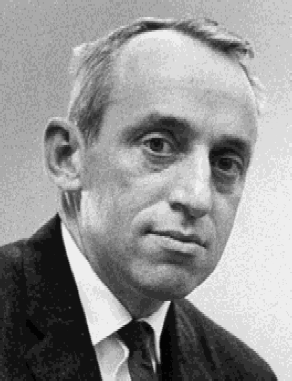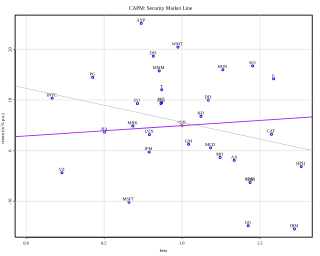Related Research Articles

James Tobin was an American economist who served on the Council of Economic Advisers and consulted with the Board of Governors of the Federal Reserve System, and taught at Harvard and Yale Universities. He contributed to the development of key ideas in the Keynesian economics of his generation and advocated government intervention in particular to stabilize output and avoid recessions. His academic work included pioneering contributions to the study of investment, monetary and fiscal policy and financial markets. He also proposed an econometric model for censored dependent variables, the well-known tobit model.
Financial economics is the branch of economics characterized by a "concentration on monetary activities", in which "money of one type or another is likely to appear on both sides of a trade". Its concern is thus the interrelation of financial variables, such as share prices, interest rates and exchange rates, as opposed to those concerning the real economy. It has two main areas of focus: asset pricing and corporate finance; the first being the perspective of providers of capital, i.e. investors, and the second of users of capital. It thus provides the theoretical underpinning for much of finance.

Franco Modigliani was an Italian-American economist and the recipient of the 1985 Nobel Memorial Prize in Economics. He was a professor at University of Illinois at Urbana–Champaign, Carnegie Mellon University, and MIT Sloan School of Management.
An economic bubble is a period when current asset prices greatly exceed their intrinsic valuation, being the valuation that the underlying long-term fundamentals justify. Bubbles can be caused by overly optimistic projections about the scale and sustainability of growth, and/or by the belief that intrinsic valuation is no longer relevant when making an investment. They have appeared in most asset classes, including equities, commodities, real estate, and even esoteric assets. Bubbles usually form as a result of either excess liquidity in markets, and/or changed investor psychology. Large multi-asset bubbles, are attributed to central banking liquidity.

In finance, the capital asset pricing model (CAPM) is a model used to determine a theoretically appropriate required rate of return of an asset, to make decisions about adding assets to a well-diversified portfolio.
The equity premium puzzle refers to the inability of an important class of economic models to explain the average equity risk premium (ERP) provided by a diversified portfolio of equities over that of government bonds, which has been observed for more than 100 years. There is a significant disparity between returns produced by stocks compared to returns produced by government treasury bills. The equity premium puzzle addresses the difficulty in understanding and explaining this disparity. This disparity is calculated using the equity risk premium:
Sanford "Sandy" Jay Grossman is an American economist and hedge fund manager specializing in quantitative finance. Grossman’s research has spanned the analysis of information in securities markets, corporate structure, property rights, and optimal dynamic risk management. He has published widely in leading economic and business journals, including American Economic Review, Journal of Econometrics, Econometrica, and Journal of Finance. His research in macroeconomics, finance, and risk management has earned numerous awards. Grossman is currently Chairman and CEO of QFS Asset Management, an affiliate of which he founded in 1988. QFS Asset Management shut down its sole remaining hedge fund in January 2014.

Lars Peter Hansen is an American economist. He is the David Rockefeller Distinguished Service Professor in Economics, Statistics, and the Booth School of Business, at the University of Chicago and a 2013 recipient of the Nobel Memorial Prize in Economics.
The goals of experimental finance are to understand human and market behavior in settings relevant to finance. Experiments are synthetic economic environments created by researchers specifically to answer research questions. This might involve, for example, establishing different market settings and environments to observe experimentally and analyze agents' behavior and the resulting characteristics of trading flows, information diffusion and aggregation, price setting mechanism and returns processes.

Grzegorz Witold Kołodko is a distinguished professor of economics. A key architect of Polish economic reforms. He is the author of New Pragmatism original paradigmatic and heterodox theory of economics. University lecturer, researcher, the author of numerous academic books and research papers. As Deputy Premier and Minister of Finance of Poland in 2002–2003 he played a leading role in achieving the entry of Poland into the European Union. Holding the same position in 1994–1997, Kolodko led Poland into the OECD.
The following outline is provided as an overview of and topical guide to finance:
Robert (Bob) Arthur Haugen was a financial economist and a pioneer in the field of quantitative investing and low-volatility investing. He was President of Haugen Custom Financial Systems and also consulted and spoke globally.

Markus Konrad Brunnermeier is an economist, who is the Edwards S. Sanford Professor of Economics at Princeton University.

Hyun Song Shin is a South Korean economic theorist and financial economist who focuses on global games. He has been the Economic Adviser and Head of Research of the Bank for International Settlements (BIS) since May 1, 2014.
Colm Kearney (1954–2018) was an Irish economist and academic, who was dean of the Faculty of Business and Economics at Monash University, Melbourne, Australia, until 2017, shortly before his death on 28 March 2018.
John Geanakoplos is an American economist, and the current James Tobin Professor of Economics at Yale University.
David Alan Easley is an American economist. Easley is the Henry Scarborough Professor of Social Science and is a professor of information science at Cornell University.
Mathematical finance, also known as quantitative finance and financial mathematics, is a field of applied mathematics, concerned with mathematical modeling of financial markets.
Factor investing is an investment approach that involves targeting quantifiable firm characteristics or “factors” that can explain differences in stock returns. Security characteristics that may be included in a factor-based approach include size, low-volatility, value, momentum, asset growth, profitability, leverage, term and carry.
References
- 1 2 3 4 "Timothy C. Johnson". illinois.edu. Retrieved March 31, 2024.
- ↑ "Tim Johnson". illinois.edu. Retrieved May 13, 2017.
- 1 2 Johnson, Timothy (2002). "Rational Momentum Effects". The Journal of Finance (57): 585–608.
- ↑ "Unobservable persistence : an economic theory of stochastic volatility".
- ↑ "Members of the Corporation". Annual Report of the Trustees of the Metropolitan Museum of Art (122): 101–104. 1992. JSTOR 40304980 . Retrieved 24 January 2022.
- ↑ Johnson, Timothy (2004). "Forecast Dispersion and the Cross Section of Expected Return". The Journal of Finance (59): 1957–1978.
- ↑ Johnson, Timothy (2006). "Dynamic liquidity in endowment economies". Journal of Financial Economics (80): 531–562.
- ↑ Johnson, Timothy (2008). "Volume, liquidity, and liquidity risk". Journal of Financial Economics (87): 388–417.
- ↑ Hackbarth, D; Johnson, Timothy (2015). "Real Options and Risk Dynamics". The Review of Economic Studies (82): 1449–1482.
- ↑ Johnson, Timothy (2022). "Economic Uncertainty, Aggregate Debt, and the Real Effects of Corporate Finance". Critical Finance Reviews (11): 79–116.